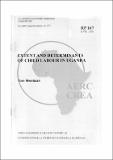| dc.description.abstract | Despite the prevalence and the many dangers associated with child labour, the
phenomenon has received the attention of researchers, academicians and policy makers
only recently, and not until International Labour Organization (ILO) estimates showed
a large and increasing number of working children worldwide. It is now recognized that
in order to combat child labour effectively, policies should be grounded in an informed
understanding of its causes, roles and implications. This study uses data from the 1992,
1999 and 2002 Uganda National Household Surveys to explore the extent, determinants
and forms of child labour in a poor but growing economy. Of note here is that over this
period Uganda introduced universal and compulsory primary education.
The study highlights the extent, characteristics and determinants of child labour in
Uganda and their evolution over the decade. The theoretical framework is a standard
household production model that analyses the allocation of time within the household.
Using probit and tobit models, we estimate the determinants of child labour for the
individual child worker. The results indicate that child labour is still common, widespread
and starts at an early age in Uganda, although it has reduced significantly over the years.
Education and formal employment of the household head significantly decrease the
probability that a child will work. Household welfare is another indicator of child labour,
as poor households are more likely to have working children. A comparison of the three
data sets reveals an increase in the percentage of children combining work and study
over time. Nevertheless, the likelihood of child labour increases with the age of the
child. The findings provide important results for informing policies to reduce, and
possibly eliminate, child labour in the country. | en_GB |


